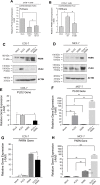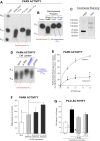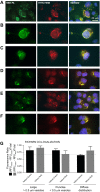A feedback mechanism between PLD and deadenylase PARN for the shortening of eukaryotic poly(A) mRNA tails that is deregulated in cancer cells
- PMID: 28011629
- PMCID: PMC5312095
- DOI: 10.1242/bio.021261
A feedback mechanism between PLD and deadenylase PARN for the shortening of eukaryotic poly(A) mRNA tails that is deregulated in cancer cells
Abstract
The removal of mRNA transcript poly(A) tails by 3'→5' exonucleases is the rate-limiting step in mRNA decay in eukaryotes. Known cellular deadenylases are the CCR4-NOT and PAN complexes, and poly(A)-specific ribonuclease (PARN). The physiological roles and regulation for PARN is beginning to be elucidated. Since phospholipase D (PLD2 isoform) gene expression is upregulated in breast cancer cells and PARN is downregulated, we examined whether a signaling connection existed between these two enzymes. Silencing PARN with siRNA led to an increase in PLD2 protein, whereas overexpression of PARN had the opposite effect. Overexpression of PLD2, however, led to an increase in PARN expression. Thus, PARN downregulates PLD2 whereas PLD2 upregulates PARN. Co-expression of both PARN and PLD2 mimicked this pattern in non-cancerous cells (COS-7 fibroblasts) but, surprisingly, not in breast cancer MCF-7 cells, where PARN switches from inhibition to activation of PLD2 gene and protein expression. Between 30 and 300 nM phosphatidic acid (PA), the product of PLD enzymatic reaction, added exogenously to culture cells had a stabilizing role of both PARN and PLD2 mRNA decay. Lastly, by immunofluorescence microscopy, we observed an intracellular co-localization of PA-loaded vesicles (0.1-1 nm) and PARN. In summary, we report for the first time the involvement of a phospholipase (PLD2) and PA in mediating PARN-induced eukaryotic mRNA decay and the crosstalk between the two enzymes that is deregulated in breast cancer cells.
Keywords: Breast cancer; Cell signaling; Deadenylase; Gene expression; MRNA decay; Mammalian cells; Ribonuclease.
© 2017. Published by The Company of Biologists Ltd.
Conflict of interest statement
The authors declare no competing or financial interests.
Figures








Similar articles
-
How miRs and mRNA deadenylases could post-transcriptionally regulate expression of tumor-promoting protein PLD.Adv Biol Regul. 2018 May;68:107-119. doi: 10.1016/j.jbior.2017.08.002. Epub 2017 Aug 24. Adv Biol Regul. 2018. PMID: 28964725 Free PMC article. Review.
-
Activity and Function of Deadenylases.Enzymes. 2012;31:181-211. doi: 10.1016/B978-0-12-404740-2.00009-4. Epub 2012 Sep 29. Enzymes. 2012. PMID: 27166446
-
Modulation of poly(A)-specific ribonuclease (PARN): current knowledge and perspectives.Curr Med Chem. 2012;19(28):4838-49. doi: 10.2174/092986712803341539. Curr Med Chem. 2012. PMID: 22834816 Review.
-
Phosphatidic Acid Increases Epidermal Growth Factor Receptor Expression by Stabilizing mRNA Decay and by Inhibiting Lysosomal and Proteasomal Degradation of the Internalized Receptor.Mol Cell Biol. 2015 Sep;35(18):3131-44. doi: 10.1128/MCB.00286-15. Epub 2015 Jun 29. Mol Cell Biol. 2015. PMID: 26124282 Free PMC article.
-
Poly(A)-specific ribonuclease (PARN): an allosterically regulated, processive and mRNA cap-interacting deadenylase.Crit Rev Biochem Mol Biol. 2013 Mar-Apr;48(2):192-209. doi: 10.3109/10409238.2013.771132. Epub 2013 Mar 15. Crit Rev Biochem Mol Biol. 2013. PMID: 23496118 Review.
Cited by
-
PARN Knockdown in Cell Lines Results in Differential and Cell-Specific Alterations in the Expression of Cancer-Associated mRNAs.Asian Pac J Cancer Prev. 2022 Jan 1;23(1):207-215. doi: 10.31557/APJCP.2022.23.1.207. Asian Pac J Cancer Prev. 2022. PMID: 35092390 Free PMC article.
-
D-series Resolvins activate Phospholipase D in phagocytes during inflammation and resolution.FASEB J. 2020 Dec;34(12):15888-15906. doi: 10.1096/fj.201903025RR. Epub 2020 Oct 12. FASEB J. 2020. PMID: 33047359 Free PMC article.
-
How miRs and mRNA deadenylases could post-transcriptionally regulate expression of tumor-promoting protein PLD.Adv Biol Regul. 2018 May;68:107-119. doi: 10.1016/j.jbior.2017.08.002. Epub 2017 Aug 24. Adv Biol Regul. 2018. PMID: 28964725 Free PMC article. Review.
-
Oxidized LDL phagocytosis during foam cell formation in atherosclerotic plaques relies on a PLD2-CD36 functional interdependence.J Leukoc Biol. 2018 May;103(5):867-883. doi: 10.1002/JLB.2A1017-407RR. Epub 2018 Apr 14. J Leukoc Biol. 2018. PMID: 29656494 Free PMC article.
References
-
- Boele J., Persson H., Shin J. W., Ishizu Y., Newie I. S., Sokilde R., Hawkins S. M., Coarfa C., Ikeda K., Takayama K.-i. et al. (2014). PAPD5-mediated 3′ adenylation and subsequent degradation of miR-21 is disrupted in proliferative disease. Proc. Natl. Acad. Sci. USA 111, 11467-11472. 10.1073/pnas.1317751111 - DOI - PMC - PubMed
Grants and funding
LinkOut - more resources
Full Text Sources
Other Literature Sources

